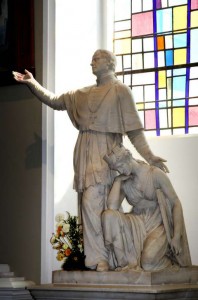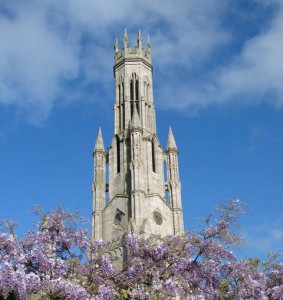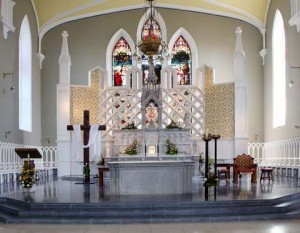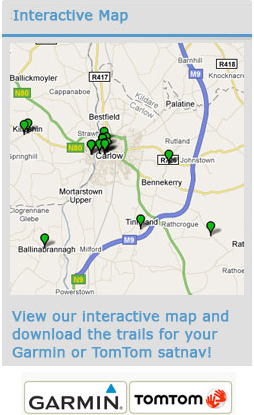Carlow Cathedral
Carlow – Ceatharlach
Carlow Town, the county capital is strategically positioned at the meeting point of the Rivers Barrow and Burrin. This trail enjoys a strong association with St. Patrick, Ireland’s national saint. Relax and enjoy discovering its rich Christian heritage in settings which radiate peace and spirituality.
1. Carlow Cathedral was built between 1828-33 to replace a parish chapel which had become too small for the growing population of the town. It was among the first Catholic cathedrals consecrated following the act granting Catholic Emancipation ![]() in 1829.
in 1829.
The cathedral was built by Bishop James Doyle (known as JKL) and financed through public subscription. Bishop Doyle, viewed by many historians as the outstanding bishop of the nineteenth century, was a church reformer, a prolific political writer on the state of Ireland and a prominent social activist. He was renowned for his evidence on Catholic Emancipation ![]() delivered before British Parliamentary committees. His impressive marble memorial statue, carved by the Irish sculptor John Hogan in Rome, represents the bishop with one arm aloft and the other resting on the shoulder of a figure symbolising Ireland, kneeling by his side in an attitude of hope.
delivered before British Parliamentary committees. His impressive marble memorial statue, carved by the Irish sculptor John Hogan in Rome, represents the bishop with one arm aloft and the other resting on the shoulder of a figure symbolising Ireland, kneeling by his side in an attitude of hope.
The cathedral’s architect was Thomas Cobden and it is generally regarded as his most outstanding church building. The granite, neo-Gothic ![]() exterior features a graceful entrance tower which rises some 46 metres and may have been modelled on the Cloth Hall in Bruges, Belgium and medieval towers in England.
exterior features a graceful entrance tower which rises some 46 metres and may have been modelled on the Cloth Hall in Bruges, Belgium and medieval towers in England.
The tower and the façade incorporate some typical Cobden features and decorative flourishes. Before entering the church one should notice the memorial stones marking the burial places of bishops of Kildare and Leighlin.
The interior of the Cathedral was originally very simple with wooden altars and wooden altar rails. The framed-roof was constructed from oak timbers from nearby Oak Park. The original altar rails were removed during renovations in the late nineteenth century and replaced with marble. The most recent refurbishment, which took place in the 1990s, has seen the removal of some of the additions and the reinstatement of Cobden’s original bishop’s throne. The choir stalls also date from Cobden’s time. Among the new features introduced in the 1990s is the baptismal font which is placed right under the central arch of the north transept.
Open: Monday – Friday 7.15 a.m. – 7 p.m., Saturday 9 a.m. – 7.30 p.m. and Sunday 7.45 a.m. – 8 p.m. | Admission: Free
![]() Catholic Emancipation – The repeal of the discriminatory Penal Laws which was completed by 1829.
Catholic Emancipation – The repeal of the discriminatory Penal Laws which was completed by 1829.
![]() Penal Laws – Legislation passed between 1695 and 1728 which severely curtailed the practice of the Catholic religion in Ireland and the participation of Catholics in public life.
Penal Laws – Legislation passed between 1695 and 1728 which severely curtailed the practice of the Catholic religion in Ireland and the participation of Catholics in public life.
![]() Gothic – Style of architecture, originating in the middle ages, characterised by pointed arches. When used in more recent times, it is described as neo-Gothic or Gothic revival.
Gothic – Style of architecture, originating in the middle ages, characterised by pointed arches. When used in more recent times, it is described as neo-Gothic or Gothic revival.





Comments are closed.